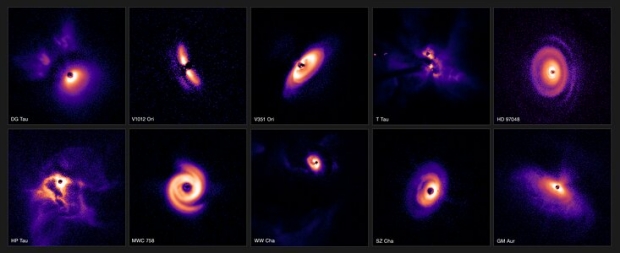Centauri Dreams
Imagining and Planning Interstellar Exploration
Inscribing Our Journey to Europa
We’re a species that likes to leave evidence of itself in new places. In Greenland, for example, the Kingittorsuaq runestone, dating from the 14th Century, offers inscriptions that help chart Norse exploration of the region. The oldest inscription at New Mexico’s El Morro dates from 1605, though many explorers left their names and stories on the cliffs there. Apollo 11’s plaque, with its “We came in peace for all mankind” is justly famous, as are the Golden Records of the two Voyagers and the Pioneer plaques, even if the latter were dogged with controversy at the time of their unveiling.

Image: The Kingittorsuaq runestone. Credit: Ukendt /Nationalmuseet, Danmark, CC BY-SA 2.5 DK
Clearly the Solar System is wide open for future plaques and markers, so that NASA’s inclusion of a plaque aboard Europa Clipper comes as no surprise. The poem it carries focuses, of course, on that intriguing moon, and I rather like poet Ada Limón’s “In Praise of Mystery: A Poem for Europa” except for its first stanza. I snag on the word ‘expansiveness,’ and the notion of a sky inky with it. The word ‘expanse’ is itself so liminal, especially as applied to an inky night sky, that it carries its own freight of awe.
To this jaded ear, ‘expansiveness’ is bloated. I can’t imagine saying ‘the sky is certainly inky with expansiveness tonight.’ So I’ll pass on stanza 1, but go for the rest of the poem, which is a deft evocation of water’s place in our evolution and our explorations:
Arching under the night sky inky
with black expansiveness, we point
to the planets we know, we
pin quick wishes on stars. From earth,
we read the sky as if it is an unerring book
of the universe, expert and evident.
Still, there are mysteries below our sky:
the whale song, the songbird singing
its call in the bough of a wind-shaken tree.
We are creatures of constant awe,
curious at beauty, at leaf and blossom,
at grief and pleasure, sun and shadow.
And it is not darkness that unites us,
not the cold distance of space, but
the offering of water, each drop of rain,
each rivulet, each pulse, each vein.
O second moon, we, too, are made
of water, of vast and beckoning seas.
We, too, are made of wonders, of great
and ordinary loves, of small invisible worlds,
of a need to call out through the dark.
Those last three stanzas form a fine conclusion; the poem ends with a satisfying click describing its mission, which is to fly aboard Europa Clipper and wind up hurtling past the target world again and again, battered by radiation as it hunts for information about an alien sea. What a good thing it is to put human artifacts on spacecraft. There is scant likelihood, of course, that the Europa poem, flying along with a microchip containing 2.6 million names submitted by the public, will one day be read by anyone, but the impulse is to commemorate and inspire ourselves. It’s something we humans do.
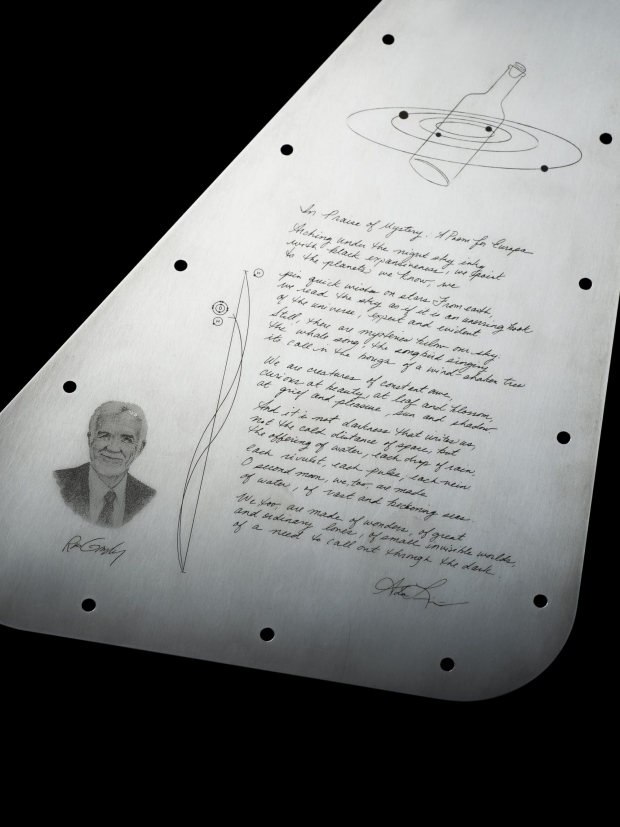
Image: The lower half of Europa Clipper’s vault plate, showing the poem by U.S. poet laureate Ada Limón (lower right), a drawing representing the Jovian system that will host the names of 2.6 million people flying with the mission on a microchip (top right), a tribute to planetary scientist Ron Greely (bottom left), and the radio emission lines known as the ‘Water Hole’ (center). Credit: NASA/JPL-Caltech.
As a collector and user of vintage fountain pens, I am particularly pleased to see that the poem is inscribed in the author’s handwriting, a nice touch in an era increasingly learning that writing by hand, though rarely taught these days, is actually a powerful way to explore and retain ideas. The vault plate, which you can explore here, likewise contains Frank Drake’s handwriting. Drake (1930-2022), among much else in a magnificent career, contributed the first SETI search, at Green Bank in West Virginia, and the seminal Drake Equation, which estimates the probability of finding life elsewhere in the cosmos and describes the factors critical to the discussion.

Image: The upper half of Europa Clipper’s vault plate, showing the Drake Equation in Frank Drake’s own handwriting. Credit: NASA/JPL-Caltech
The Europa Clipper vault plate is small, measuring 1 millimeter in thickness and 18 X 28 centimeters. What I’ve described so far is the inner-facing plate. The outer side contains a visual representation of the word for ‘water’ spoken in 103 languages, with the central symbol the sign for water in American Sign Language. Water, after all, is why we are probing Europa. Audio renditions of these words are contained as visual waveforms representing each sound. They look a bit runic to me.
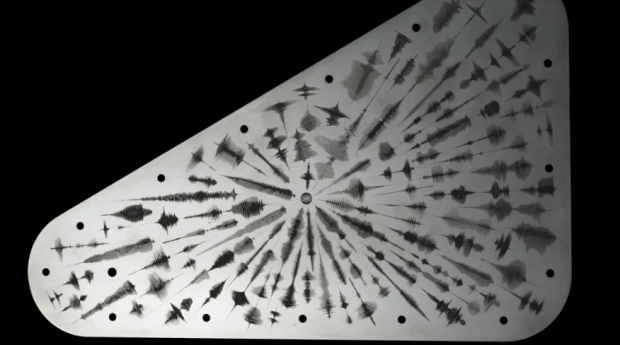
Image: The art on this side of the plate, which will seal an opening of the vault on NASA’s Europa Clipper, features waveforms that are visual representations of the sound waves formed by the word “water” in 103 languages. At center is a symbol representing the American Sign Language sign for “water.” Credit: NASA/JPL-Caltech.
We’re going to get 49 close passes of Europa if all goes well when the spacecraft arrives in 2030. The commemorative plate seals an opening in the metal vault which will protect the craft’s sensitive electronics from the sleet of particles produced by interactions between the planet and its magnetic fields. We can hope to learn a good deal more about the thickness of the moon’s icy crust, its interactions with the ocean below, the composition of that ocean, and the geology of the surface. We’re getting close to Europa Clipper’s launch, slated for October at Kennedy Space Center.
Jupiter’s radiation belts, we’ve recently learned, may play a role in what goes on in the ocean below. As a paper in Nature Astronomy explains, the bombardment of ionized particles can split any water molecules encountered on the surface, producing oxygen that could find its way into the ocean. Thus lead author Jamey Szalay (Princeton University):
“Europa is like an ice ball slowly losing its water in a flowing stream. Except, in this case, the stream is a fluid of ionized particles swept around Jupiter by its extraordinary magnetic field. When these ionized particles impact Europa, they break up the water-ice molecule by molecule on the surface to produce hydrogen and oxygen. In a way, the entire ice shell is being continuously eroded by waves of charged particles washing up upon it.”
The Juno spacecraft’s Jovian Auroral Distributions Experiment (JADE) instrument flew within 354 kilometers of the surface in September of 2022, measuring the hydrogen and oxygen ions created by the particle bombardment. The work allowed a calculation of the rate of oxygen being produced at Europa, which turns out to be about 12 kilograms per second (previous estimates have reached as high as 1000 kilograms per second). “[W]hat we didn’t realize,” adds Szalay, “is that Juno’s observations would give us such a tight constraint on the amount of oxygen produced in Europa’s icy surface.” How much of this oxygen, if any, works its way into the ocean to provide potential metabolic energy is something Europa Clipper should help us understand.
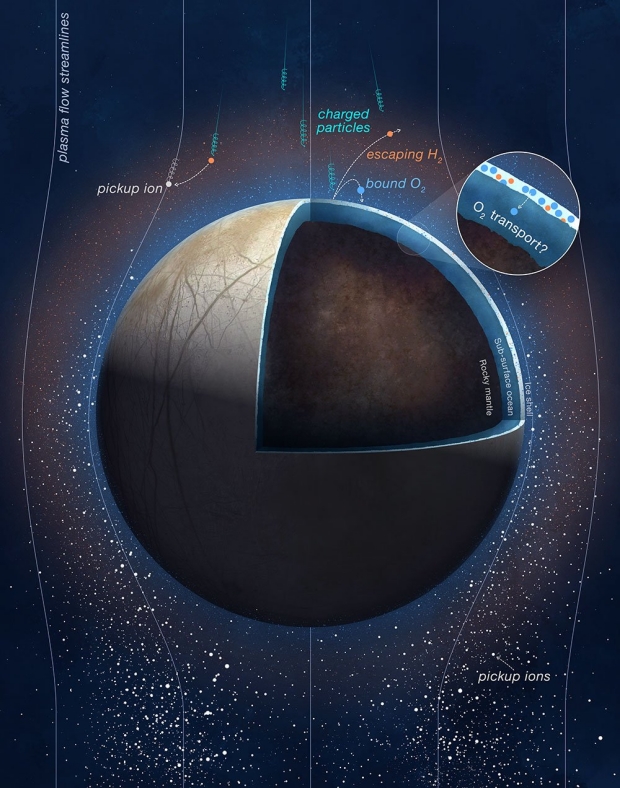
Image: This illustration shows charged particles from Jupiter impacting Europa’s surface, splitting frozen water molecules into oxygen and hydrogen molecules. Scientists believe some of these newly created oxygen gases could migrate toward the moon’s subsurface ocean, as depicted in the inset image. Credit: NASA/JPL-Caltech/SWRI/PU.
The paper is Szalay et al., “Oxygen production from dissociation of Europa’s water-ice surface,” Nature Astronomy 04 March 2024 (full text).

An Ancient ‘Quenched’ Galaxy
If individual star systems show us a wide variety of formation scenarios – and we just examined recent ESO work on circumstellar disks in different star-forming regions – the variety in galaxy evolution is even more spectacular. I’m reminded here of an unusual find when my uncle Roland died unexpectedly and I became his executor. Clearing out his house preparatory to sale, I discovered a series of astronomy photographs that he had blown up to huge scale. An image of M31, the great spiral of Andromeda, was fully six feet long and gorgeously mounted. I remembered nights as a child when he would visit from Florida and point out celestial objects for me to observe with my 3-inch reflector. M31, he told me then, was considerably wider than the Moon in the sky.
When I checked, I found that Andromeda had an angular size of 3 degrees, as opposed to about half a degree for the Moon. Even so, our spectacular sister galaxy is actually a difficult catch, with only its brighter central region visible to the naked eye, and even there tricky to find depending on local conditions of light pollution. Here I chuckle, remembering that I inherited from my uncle his eight-inch Celestron. The bane of his life was his backyard neighbor, who would power up huge outdoor security lights at the most inappropriate times. No luck seeing M31 under those conditions!
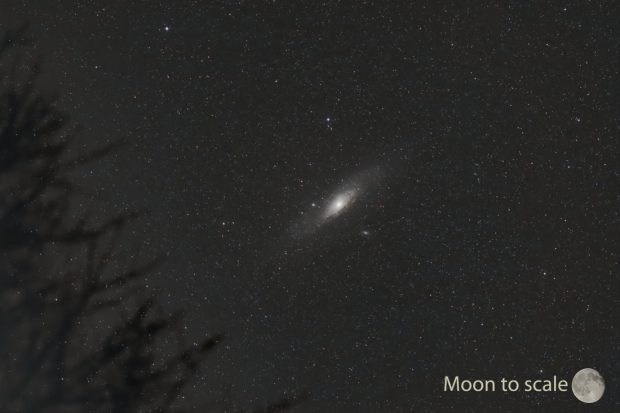
Image: M31 through a small telescope, with the Moon’s size shown for reference. Credit: Caradon Observatory.
Timothy Ferris produced a spectacular book called, simply, Galaxies, published by Random House in 1988. If you’re a deep sky devotee, it’s worth seeking out in a used book store, as it’s a coffee-table volume with spectacular photography. The following passage captures some of the grandeur verbally, though it’s from Ferris’ equally valuable Seeing in the Dark (Simon & Schuster, 2002):
The very concept of space is inadequate for dealing with galaxies; one must invoke time as well. The Andromeda galaxy is steeply inclined to our line of sight, only fifteen degrees from edge-on. Since the visible part of its disk is roughly one hundred thousand light years in diameter, the starlight reaching our eyes from its more distant side is about one hundred thousand years older than the light we simultaneously see coming from the near side. When the starlight from the far side of Andromeda started its journey, Homo habilis, the first true humans, did not yet exist. By the time the near-side light started out, they did. So within that single field of view lies a swath of time that brackets our ancestors’ origins – and that, like the incomplete dates in a biographical sketch of a living person (1944-?), inevitably raises the question of our destiny as a species. When the light leaving Andromeda tonight reaches Earth, 2.25 million years from now, who will be here to observe it? We think of Einstein’s spacetime as an abstraction, but to observe a galaxy is to sense its physical reality.
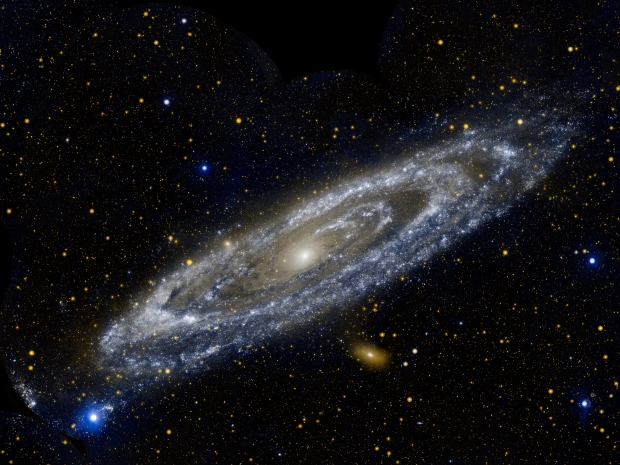
Image: An ultraviolet look at Andromeda, from NASA’s Galaxy Evolution Explorer. Credit: NASA. I owe the reminder for the Ferris quote to the blog Ten Minute Astronomy.
How much more stunning, then, to think about the galaxy recently observed by the team doing the JWST Advanced Deep Extragalactic Survey (JADES). I will mercifully shorten its designation to JADES-GS-z7-01-QU, as the authors of the paper in Nature do. This is a so-called ‘quiescent’ galaxy, meaning that for a variety of possible reasons, star formation within it has all but ceased. The authors describe it as “a compact, discy galaxy.” And as the work of the large team led by Tobias Looser (University of Cambridge) now shows, it is also the first galaxy beyond redshift z=5 to be confirmed and characterized. Indeed, the redshift calculated for this object is z=7.3. The light from this particular galaxy would have been emitted some 13 billion years ago, a ‘mere’ 700 million years after the Big Bang.
We could also look at this galaxy in terms of its ‘comoving distance.’ The latter term is used to accommodate the fact that the universe is expanding, necessary to consider here because if an object is so far away that the light from it has traveled for most of the age of the visible universe, then during that time cosmic expansion has continued. Doing the math on this is beyond my skill set, but my research indicates that at z=7.3, the comoving distance of JADES-GS-z7-01-QU should be in the range of 30 billion light years. Mathematically inclined readers might want to fine-tune that figure.
That ‘chill up the spine’ feeling of encountering deep time/distance never quite goes away. In terms of its significance, though, we can focus in on quiescence, which is a measure of how star formation ceases in a galaxy. The galaxy in question, as observed now, has stopped forming new stars (which means it did that over 13 billion years ago). The paper indicates that the quenching period occurred 10 to 20 million years ago. Star formation seems to have been fast, ending abruptly, but what we don’t know is whether this condition is permanent. Indeed, as the paper on this work points out, how star formation is regulated in galaxies is one of the key open problems in astrophysics.
The authors run through the possibilities for slowing or stopping star formation, which include gas being expelled from galaxies by supermassive black holes or rapid star formation heating the ‘circumgalactic medium,’ thereby preventing the accretion of fresh gases. Low-mass galaxies (this is one) can be affected by feedback mechanisms that deplete the medium within galactic clusters. These differing processes operate over varying timescales, making the significance of JADES-GS-z7-01-QU clear, as noted by Roberto Maiolino (University of Cambridge), a co-author on the paper:
“We’re not sure if any of those scenarios can explain what we’ve now seen with Webb. Until now, to understand the early universe, we’ve used models based on the modern universe. But now that we can see so much further back in time, and observe that the star formation was quenched so rapidly in this galaxy, models based on the modern universe may need to be revisited.”
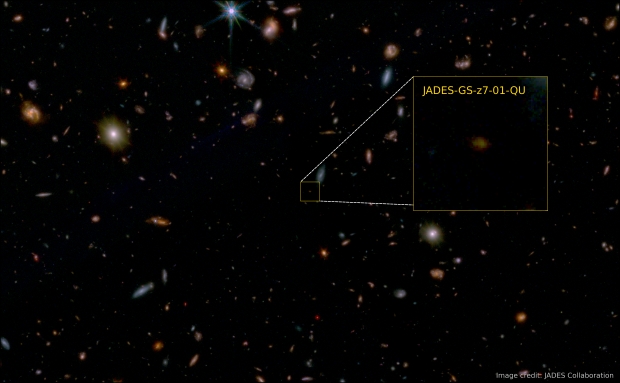
Image: False-colour JWST image of a small fraction of the GOODS South field, with JADES-GS-z7-01-QU highlighted. Credit: JADES Collaboration.
Thus we have the first of what should become many opportunities to learn about galaxy growth and transformation in the early universe. About the mass of the Small Magellanic Cloud, which continues to form new stars, this galaxy is dead as of the time of observation, but we can’t know what occurred in the 13 billion years before JWST was turned on it. Is quenching a widespread phenomena in the early universe, but a temporary one, so that later epochs see galactic rejuvenation? The scope of future work with JWST is beginning to take shape as we examine finds like these.
The paper is Looser et al. “A recently quenched galaxy 700 million years after the Big Bang,” Nature (06 March 2024). Abstract.

New Angles on Planet Formation
Planet formation is a fascinating subtopic of the exoplanet hunt, and it may just have produced the first exoplanet detection in data that go back as far back as 1981, though the event in question has never been confirmed as being caused by a planet. I learned this through a paper sent me recently by Jean Schneider (Observatoire de Paris), who along with colleague Danielle Briot wrote about the early days of transit searches in a chapter for the Handbook of Exoplanets (Springer, 2018).
I want to dig deeper into that chapter in a later post, but for now, I note that the planet Beta Pictoris b, discovered in 2008 and orbiting an infant star 63 light years from Earth, may have transited in 1981, according to subsequent papers on the matter. The debris disk around the primary has long fascinated astronomers and it has been investigated for the possible presence of comet-like bodies and subjected to direct imaging searches, which revealed Beta Pictoris b and confirmed it in 2009. But the 1981 data show light variations that could be interpreted as a transit.
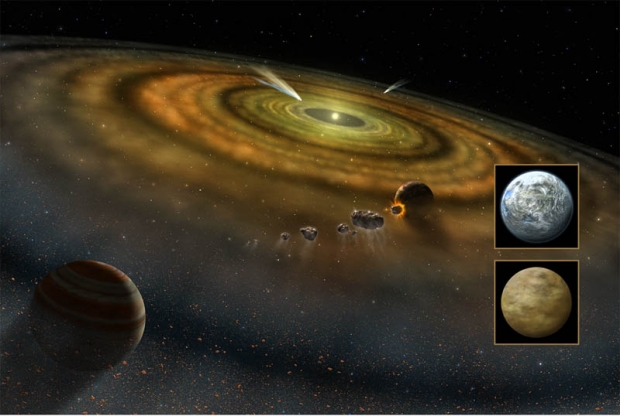
Image: Various planet formation processes, including exocomets and other planetesimals, around Beta Pictoris, a very young type A V star. Credit: NASA/FUSE/Lynette Cook.
Testing the matter involved a nano-satellite called PicSat designed by astronomers at the Paris-Meudon observatory to look for a possible 2018 transit. Unfortunately, the mission failed when communications were lost. As Schneider and Briot write:
If the transit is confirmed in the near future, we could obtain better observations of the following transit in 2053, when the period will be known more accurately and when we could use very large and extraordinary outstanding future instruments. So, will Beta Pictoris b win the title of the first detected exoplanet?
The massive debris disk at Beta Pictoris is asymmetric (likely the result of perturbations by another star), and seen edge-on from Earth. But the beauty of the circumstellar disks out of which planets form is that if we peer into planet-forming regions, we can find them oriented in all kinds of ways, as we learn in a new series of images from the European Southern Observatory’s Very Large Telescope. They’re part of a survey of how planetary systems form, and they mark a transition between the intense study of individual star systems to a broad swath of planets and stars. As Christian Ginski (University of Galway, Ireland) puts it, “We’ve gone from the intense study of individual star systems to this huge overview of entire star-forming regions.”
Let’s home in on a single system to begin with to ponder how much we can learn from these disks.
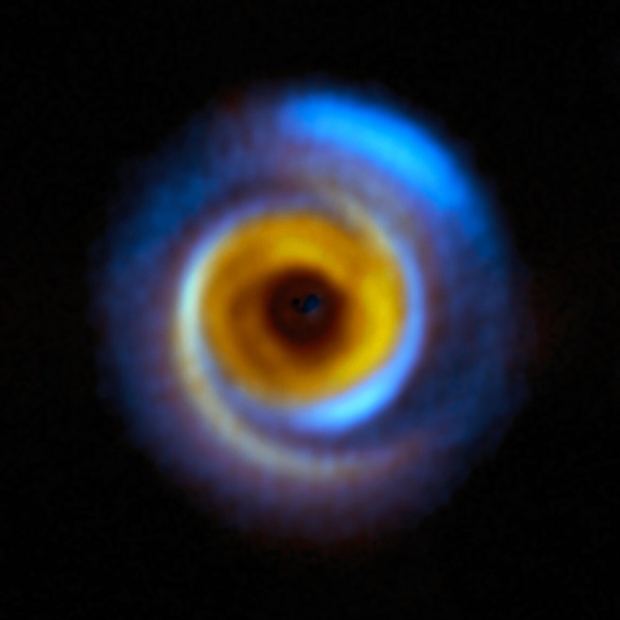
Image: This composite image shows the MWC 758 planet-forming disc, located about 500 light-years away in the Taurus region, as seen with two different facilities. The yellow colour represents infrared observations obtained with the Spectro-Polarimetric High-contrast Exoplanet REsearch (SPHERE) instrument on ESO’s Very Large Telescope (VLT). The blue regions on the other hand correspond to observations performed with the Atacama Large Millimeter/submillimeter Array (ALMA), in which ESO is a partner. These facilities allow astronomers to map how dust is distributed around this and other stars in different but complementary ways. SPHERE captures light from the host star that has been scattered by the dust around it, whereas ALMA registers radiation directly emitted by the dust itself. These observations combined help astronomers understand how planets may form in the dusty discs surrounding young stars. Credit: ESO/A. Garufi et al.; R. Dong et al.; ALMA (ESO/NAOJ/NRAO).
The new ESO imagery takes in numerous young stars like this one. What leaps out here is the wide range of formation scenarios. Working with the star-forming regions at Orion, Taurus and Chamaeleon I, an international team of astronomers investigated 86 stars using SPHERE, the Spectro-Polarimetric High-contrast Exoplanet REsearch instrument mounted on the VLT. The quality of the imagery is attributable to SPHERE’s adaptive optics, which allows disks to be imaged around stars down to about half the Sun’s mass while correcting for the distortions produced by looking through the Earth’s atmosphere. The use of ALMA, the Atacama Large Millimeter/submillimeter Array, helped quantify the amount of dust in these systems.
Image: This research brings together observations of more than 80 young stars that might have planets forming around them in spectacular discs. This small selection from the survey shows 10 discs from the three regions of our galaxy observed in the papers. V351 Ori and V1012 Ori are located in the most distant of the three regions, the gas-rich cloud of Orion, some 1600 light-years from Earth. DG Tau, T Tau, HP Tau, MWC758 and GM Aur are located in the Taurus region, while HD 97048, WW Cha and SZ Cha can be found in Chamaeleon I, all of which are about 600 light-years from Earth. The discs have been scaled to appear roughly the same size in this composition. Credit: ESO/C. Ginski, A. Garufi, P.-G. Valegård et al.
The imagery is stunning. Per-Gunnar Valegård (University of Amsterdam), who led the work on Orion, noted “It is almost poetic that the processes that mark the start of the journey towards forming planets and ultimately life in our own Solar System should be so beautiful.” I think we can drop that word ‘almost’ as we are reminded that the sheer wonder of celestial vistas at ever increasing scales is what drew many of us into astronomy at an early age. We’re a long way from those grainy Palomar images of Jupiter and Saturn that I acquired decades ago at Adler Planetarium in Chicago.
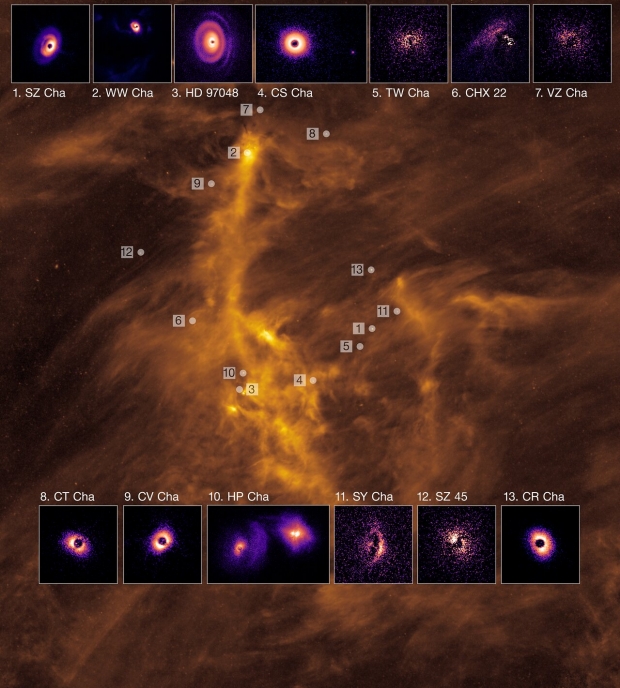
Image: Planet-forming discs around young stars and their location within the gas-rich cloud of Chamaeleon I, roughly 600 light-years from Earth. The team observed 20 stars in the Chamaeleon I region, detecting discs around 13. The background image shows an infrared view of Chamaeleon I captured by the Herschel Space Observatory. Credit: ESO/C. Ginski et al.; ESA/Herschel.
Meanwhile, in a separate investigation of the young star T Chamaeleontis, we gain insights into planet formation in its latter stages. Here we have the James Webb Space Telescope to thank. Naman Bajaj (University of Arizona) and Uma Gorti (SETI Institute) have been able to extract data on the four lines of the noble gases neon (Ne) and argon (Ar), with the neon detection showing processes that are occurring over an extended area. The observations show dispersing gasses from a planet-forming disk that is in its latter stages, completing the formation process. These ‘winds’ seem to be driven by stellar photons or, according to Bajaj, by the magnetic field within the disk itself.
The find is significant, says Richard Alexander (University of Leicester):
“We first used neon to study planet-forming discs more than a decade ago, testing our computational simulations against data from Spitzer, and new observations we obtained with the ESO VLT. We learned a lot, but those observations didn’t allow us to measure how much mass the discs were losing. The new JWST data are spectacular, and being able to resolve disc winds in images is something I never thought would be possible. With more observations like this still to come, JWST will enable us to understand young planetary systems as never before.”
The paper on the history of transit studies is Briot & Schneider, “Prehistory of Transit Searches,” in Handbook of Exoplanets, 2nd edition.
The papers on the SPHERE work are Ginski et al., “The SPHERE view of the Chamaeleon I star-forming region: The full census of planet-forming disks with GTO and DESTINYS programs”, Astronomy & Astrophysics (abstract).
And two other papers in the same issue: Garufi et al., “The SPHERE view of the Taurus star-forming region: The full census of planet-forming disks with GTO and DESTINYS programs,” (abstract) and Valegard et al., “Disk Evolution Study Through Imaging of Nearby Young Stars (DESTINYS): The SPHERE view of the Orion star-forming region” (abstract).
The paper on T Chamaeleontis is Bajaj et al., “JWST MIRI MRS Observations of T Cha: Discovery of a Spatially Resolved Disk Wind,” The Astronomical Journal Vol. 167, No. 3 (4 March 2024), 127 (abstract).

Building the Heavy Elements
A kilonova at the wrong place and time would spell trouble for any lifeforms emerging on a planetary surface. Just how we found out about kilonovae and the conditions that create them, not to mention their hypothesized effects, is the subject of Don Wilkins’ latest, a look at Cold War era surveillance that wound up pushing astronomy’s frontiers. That work now causes us to ponder the formation of an ‘island of stability’ in which exists a set of superheavy element isotopes with unique properties. It also raises interesting questions about our Solar System’s history and possible exposure to a nearby event. Based at Washington University in St. Louis, Don’s interest in deep space exploration here probes the formation and structure of matter in processes we’re only beginning to unlock.
by Don Wilkins
Setting out to discover something on Earth can sometimes reveal an unexpected result from a far more interesting source. As a case in point, consider what happened in August of 1963, when Great Britain, the US and the USSR signed a nuclear test ban treaty forbidding nuclear detonations in space or the Earth’s atmosphere. For the older space nerds, this is the same treaty that ended the Orion program. Given the Soviets’ history of violating treaties, the US launched the Vela (derived from the Spanish verb “velar”, to watch) series of satellites designed to monitor compliance with the treaty within two months of the signing. What they found was a bit of a surprise.
The satellites were heavily instrumented with x-ray, gamma-ray, neutron, optical and electromagnetic pulse (EMP) detectors along with other sensors designed to monitor the space environment. The satellites operated in pairs on opposite sides of a circular 250,000 kilometers in diameter orbit, Figure 1.
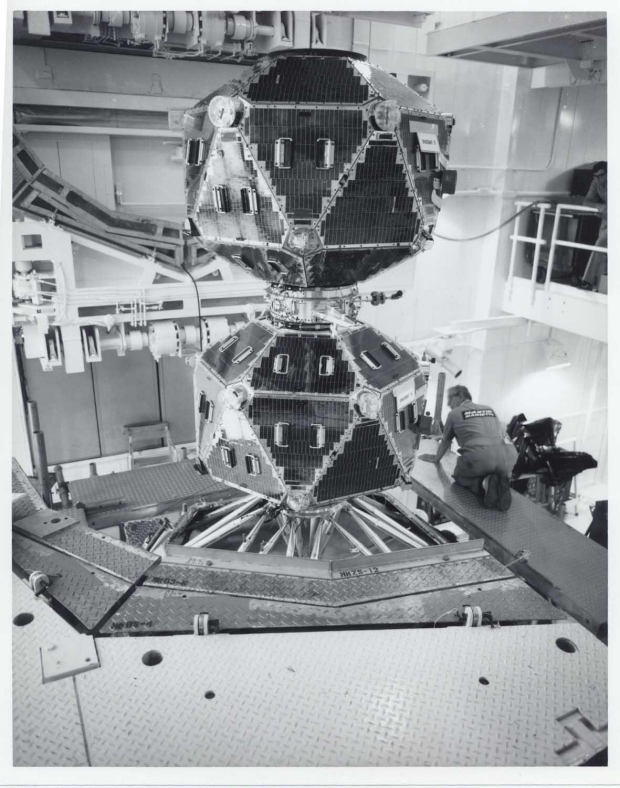
Figure 1. A Pair of Vela Satellites Readying for Launch. Los Angeles Air Force Base, U.S. Air Force Photo.
X-ray detectors directly sense nuclear blast. Gamma-ray and neutron detector activations would confirm the nuclear event and would prompt a stiffly worded diplomatic note sent to the Soviets. Vela satellites were positioned to monitor the Earth and the far side of the Moon. The latter involved detecting gamma radiation from radioactive debris scattered by a clandestine explosion. As a result of the separation of the satellites and separation in time between sensor triggering on the satellites, the angle to the event could be determined to about one-fifth of a radian or ten degrees. Angles to a single event observed by multiple pairs of satellites could provide a more precise direction to the source.
No diplomatic note concerning illegal nuclear tests was ever sent to the Soviets. Fortunately events which triggered the detectors but were clearly not signatures of nuclear detonations were not discarded. These formed a database which eventually led to the discovery of enormous, but short-lived gamma-ray bursts (GRBs) originating in deep space. GRBs last less than three seconds (although a recent discovery lasted an astounding 200 seconds), yet they are as luminous as 100 million galaxies, the equivalent of a 1000 novae. Gamma-ray sources have temperatures of approximately 109 K degrees and are among the hottest objects ever observed. Compounding the mystery, researchers only had a line pointing to the origin of the bursts but no distance.
GRBs occur daily and are uniformly distributed across the observable Universe. Initially no counterpart of the GRBs operating in the visual spectrum could be found. Then, in 1997, Italian astronomers caught the fading light of an object which could be linked with a GRB, Figure 2.

Figure 2. Left: Arrow points at the GRB optical counterpart. Right: An IR image of the tilted box area in the left image. The optical source is gone, and only a faint image of a very distant galaxy remains. The other two bright sources on the right side are spiral galaxies. Credit: W. M. Keck Observatory / NASA.
The favored explanation for GRBs is the collision of two neutron stars or two black holes. Astronomers named the neutron star mergers kilonovae (KN). In addition to GRBs, these collisions emit high-frequency gravitational waves (GW) and are, through rapid neutron capture (the r-process) nucleosynthesis, likely production sites of heavy elements. [1] A team led by Andres Levan examined spectroscopy of GRB 230307A, a long-duration GRB associated with a kilonova merger. A 2.15 micron emission line from that analysis is associated with tellurium (atomic mass 130), and a mid-IR peak, lanthanides production. GRB nucleosynthesis creates a wide range of atomic masses including heavy elements (mass above iron). [2]
These observations and others support the hypothesis that heavy elements within the Solar System are the remnants of a kilonova.[3-4]
Figure 3 depicts the evolution of a neutron star merger over the course of millennia. The drawing on the left depicts the aftermath a few years after the merger and at dimensions below a parsec. Gamma-rays are emitted in the dynamic ejecta and the hot cocoon. The gamma-ray jet and cocoon emissions are short-lived; the afterglow they produce emits broadband frequencies for several years. The dynamic ejecta include heavy elements which decay in less than a month to produce the UV, optical and IR displays. X-ray emissions, at potentially lethal levels, result from the interaction between the jet and the interstellar medium (ISM).
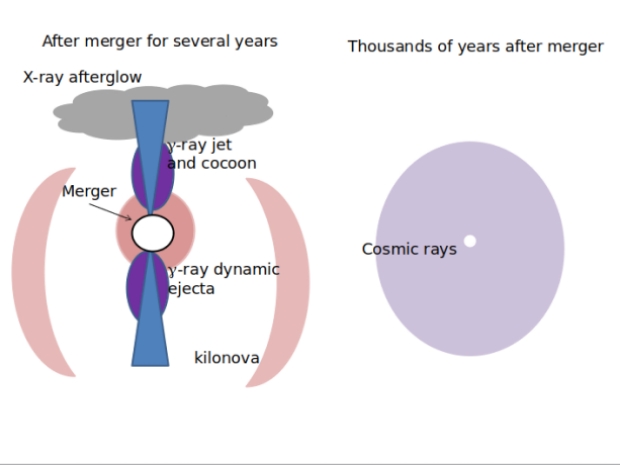
Figure 3. Structures Resulting from Neutron Star Merger
On the right hand side, a powerful shock wave from the merger produces a bubble in the ISM. Potentially lethal cosmic rays result.
Initial analysis of GRBs focused on the on-axis gamma ray bursts. M.L. Perkins’ team analyzed the data to understand threats by the off-axis emissions and the relation to other cosmic threats. [5]
According to the team:
For baseline kilonova parameters, … the X-ray emission from the afterglow may be lethal out to ∼ 5 pc and the off-axis gamma-ray emission may threaten a range out to ∼ 4 pc, whereas the greatest threat comes years after the explosion, from the cosmic rays accelerated by the kilonova blast, which can be lethal out to distances up to ∼ 11 pc. … . Based on the frequency and potential damage done, the threats in order of most to least harmful are: solar flares, impactors, supernovae, on-axis GRBs, and lastly off-axis BNS mergers.
One question concerns how close to Earth a kilonova may have manifested. The presence of two isotopes, iron-60 (Fe-60) and plutonium-244 (Pu-244) found in ocean sediments deposited 3 to 4 million years ago offers clues. These isotopes are only formed in very energetic processes.
Fe-60 can, in theory, be created in a standard supernova. Pu-244 is created only in specific classes of supernovae or the merger of a neutron star with another astronomical body, the kilonova.

Figure 4. Artist’s impression of a neutron star merger. Credit: University of Warwick / Mark Garlick.
One of the problems was the ratio between the isotopes. Researchers at the Università di Trento found, with a specific debris ejection pattern and a certain tilt of the merger event, the observed ratio of iron to plutonium isotopes could be explained by a kilonova. [6] The scientists examined rare types of supernovae such as a magneto-rotational supernova or collapsar, but concluded the kilonova was the source of the isotopes.
To determine how far from Earth the kilonova occurred, the researchers calculated the different spreads for each element based on the wind speed created by the kilonova. The answer was about 150 to 200 parsecs or about 500 to 600 light years away.
Hydrogen and helium were created with the Big Bang; heavier elements were made by fusion within the interior of stars, supernovae and kilonovae. Data provided by astronomer Jennifer Johnson from Ohio State University was used to produce the periodic table depicting the origins of elements shown in Figure 5 below.
Researchers have examined the heavy element composition of a number of stars, finding that some of these elements are the product of the radioactive decay of previously unobserved elements. [7] These predecessor elements form in a theorized “island of stability” with atomic numbers centered around 126. Isotopes in this region, beyond the fleeting transuranics, are hypothesized to possess “magic numbers” of protons and neutrons that allow them lifespans of thousands or millions of years. The rapid neutron-capture process that occurs in neutron-rich environments of neutron star mergers and supernovae appears inadequate to form the elements in the island of stability. How these transuranics were produced is a mystery.

Figure 5. Origins of Elements – Courtesy NASA’s Goddard Space Flight Center.
The effects of neutron star mergers, like rain, depends on timing. In the early stages of star formation, the collisions shower the clouds of hydrogen and helium with heavy metals necessary for life. Yet after life gained its foothold, an improperly timed – and ill-placed – kilonova could severely damage or erase what a predecessor started.
References
1. B. D. Metzger, G. Martínez-Pinedo, S. Darbha, E. Quataert, A. Arcones, D. Kasen, R. Thomas, P. Nugent, I. V. Panov, N. T. Zinner, “Electromagnetic counterparts of compact object mergers powered by the radioactive decay of r-process nuclei,” Monthly Notices of the Royal Astronomical Society, Volume 406, Issue 4, August 2010, Pages 2650–2662, https://doi.org/10.1111/j.1365-2966.2010.16864.x
2. Levan, A., Gompertz, B.P., Salafia, O.S. et al. “Heavy element production in a compact object merger observed by JWST.” Nature (2023). https://doi.org/10.1038/s41586-023-06759-1
3. Bartos, I., Marka, S. “A nearby neutron-star merger explains the actinide abundances in the early Solar System.” Nature 569, 85–88 (2019). https://doi.org/10.1038/s41586-019-1113-7
4. Watson, Darach, Hansen, Camilla J., Selsing, Jonatan, et al, “Identification of strontium in the merger of two neutron stars,’ arXiv:1910.10510 [astro-ph.HE], 23 Oct 2019
5. Perkins, M.L., Ellis, John, Fields, B.D, et al, “Could a Kilonova Kill: a Threat Assessment,” arXiv:2310.11627v1, 17 October 2023.
6. Leonardo Chiesa, et al, “Did a kilonova set off in our Galactic backyard 3.5 Myr ago?,” arXiv (2023). DOI: 10.48550/arxiv.2311.17159
7. Ian U. Roederer, et al, “Element abundance patterns in stars indicate fission of nuclei heavier than uranium,” Science, 7 Dec 2023, Vol 382, Issue 6675, pp. 1177-1180, DOI: 10.1126/science.adf1341

Close Stellar Encounters and Earth’s Orbit
Galaxies look fixed in astronomical photos, but of course they’re dynamic systems ever in motion. The closest stars to Earth at Alpha Centauri will eventually close to within about 3 light years if we wait thirty thousand years or so. After that, as the system moves away again, Ross 248 will emerge as the closest interstellar target, closing to about the same distance before moving off into the night. But that will require waiting a bit longer, on the order of another 6000 years. We might also keep an eye on Gliese 445, which in 46,000 years or so will close to less than 4 light years of the Sun.
So everything is moving all the time, and we can say something more about future encounters. The REsearch Consortium On Nearby Stars (RECONS) has found that within the local 10-parsec volume, 81 percent of the 357 main sequence stars in its stellar census are less than half as massive as the Sun. That’s about the current estimate for the percentage of stars in the galaxy that are M-dwarfs, and we might expect that most close passages to our system have been and will be with this type of star.
The average distance between these stars is 3.85 light years, which again is close to what we see locally, since the Alpha Centauri stars are not far beyond that range from us. In this collection of stars, 232 single-star systems appear, and 85 multiples. This has led to interesting speculations, such as Bradley Hansen and Ben Zuckerman’s work at UCLA arguing that if stars get close enough, interstellar flight between them is more feasible. Suppose a star at 14,000 AU and the prospect seems more workable.
Stars do indeed get that close, as the example of Gliese 710 shows. If we’re patient, we can wait out the 1.3 million years it is projected for this to happen, for this star, on the borderline between M-dwarf and K-class, is headed our way from its current vantage in the constellation Serpens Cauda. As it will eventually be well inside the Oort Cloud, we can imagine quite an impact on cometary orbits and planetary ones as well over the long haul, as the paper I’m about to discuss shows. But before leaving Hansen and Zuckerman, let me mention that they calculate that if we widen the timeframe to a billion years, the likelihood of a star getting as close as 5000 AU is 81 percent.
Now let’s flip the question backward in time. Scholz’s Star (WISE J072003.20-084651.2) moved near our system about 70,000 years ago, reaching by current estimates somewhere between 52,000 AU and 68,000 AU from the Sun. Here we’ve got a binary consisting of an M-dwarf and a probable brown dwarf companion at 0.8 AU.
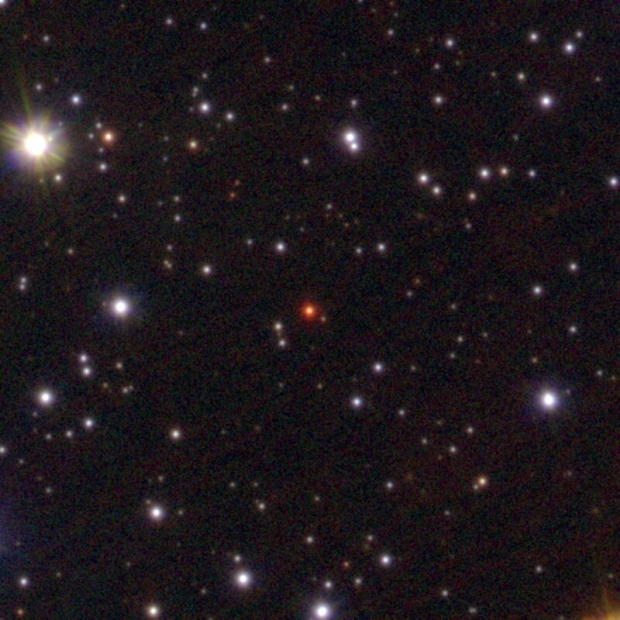
Image: Now about 20 light years away, Scholz’s Star (red star in the center) and its brown dwarf companion passed close to the Solar System and remained within 100,000 AU for a period of roughly 10,000 years. Image Credit: ESO VPHAS / Wikimedia Commons CC BY-SA 4.0.
Nathan Kaib (Planetary Science Institute) and Sean Raymond (Laboratoire d’Astrophysique de Bordeaux, CNRS) have gone to work on the question of passing stars as it relates to the Solar System’s evolution. Study the changes that have occurred in Earth’s climate over the millennia and it appears that fluctuations in the eccentricity of Earth’s orbit are involved. Kaib points to a specific episode that is illuminated by the analysis in this paper:
“One example of such an episode is the Paleocene-Eocene Thermal Maximum 56 million years ago, where the Earth’s temperature rose 5-8 degrees centigrade. It has already been proposed that Earth’s orbital eccentricity was notably high during this event, but our results show that passing stars make detailed predictions of Earth’s past orbital evolution at this time highly uncertain, and a broader spectrum of orbital behavior is possible than previously thought.”
So we’re digging into the history of our planet’s orbit, along with that of the other planets. The authors’ research shows that stellar encounters are not uncommon. A star passes within 50,000 AU on average every million years, and within 10,000 AU every 20 million years. To study the matter, Kaib and Raymond use a hybrid integrator – a set of specialized numerical methods – called MERCURY to simulate these encounters, under conditions described in the paper. The computer runs show that orbital changes to Earth do indeed result, or are at least accelerated, by perturbations from other stars.
Complicating these calculations is the fact that orbital evolution is chaotic, so that beyond timescales on the order of 100 million years, it is impossible to do more than characterize it statistically. The authors point out that even the long-term stability of the Solar System is not guaranteed, as over the Sun’s lifetime there is a 1 percent chance that Mercury will be lost by collision with either the Sun or Venus.
Earth’s past or future orbital evolution can only be confidently predicted inside a time horizon much shorter than Earth’s age, as small uncertainties in current planetary orbits eventually lead to dramatically divergent behavior. The time horizon set by the internal chaos among the Sun’s eight planets is ∼70 Myr, but additional strong chaos resulting from encounters between large asteroids shortens the horizon by another ∼10 Myr (Laskar et al. 2011b). However, inside this time horizon, backward integration of the Sun’s planets has been used to predict the detailed past orbital evolution of the Earth (Laskar et al. 2004).
Such perturbations make it difficult to pin down Earth’s orbital evolution the farther back in time we go, and it appears as well that perturbations from asteroid interactions are less significant than stellar encounters in degrading our ability to predict orbital changes. That’s useful information, because most simulations of the long-term evolution of the planetary orbits have modeled the Solar System in isolation. Changes in Earth’s orbit can also be the result of interactions with the giant planets, but a passing star can affect their orbits, which in turn impacts Earth’s orbital trajectory. Indeed, adding the giant planets to the simulations shows what a major factor these worlds are on Earth’s orbit once they themselves are perturbed by the passing star. Kaib and Raymond call them “a dynamical link that ultimately allows the Milky Way’s stars to influence the long-term evolution of Earth’s orbit.”
The paper turns to a specific encounter, that with the star HD 7977, which is a G-class star in Cassiopeia now some 250 light years away. 2.8 million years ago, this star moved past the Solar System at about 27 kilometers per second, its trajectory taking it somewhere in the neighborhood of 13,200 AU from the Sun, although the authors point out the wide cone of uncertainty about the distance, which may have been as little as 3900 AU. The ‘impulse gradient’ that shows the level of perturbation to the planets was over an order of magnitude higher than the norm during this time.
Working this into their models, the authors find that the median value of 13,200 AU would have had little effect on the Solar System’s long term chaotic evolution, but a passage at 3900 AU would have affected the eccentricity of Earth’s orbit. This is in addition, of course, to whatever effect such a close passage would have on Oort Cloud objects. A passage at 3900 AU would be one of the ten most powerful encounters experienced in the history of our system given the star’s above average mass and an encounter velocity that is below the average.
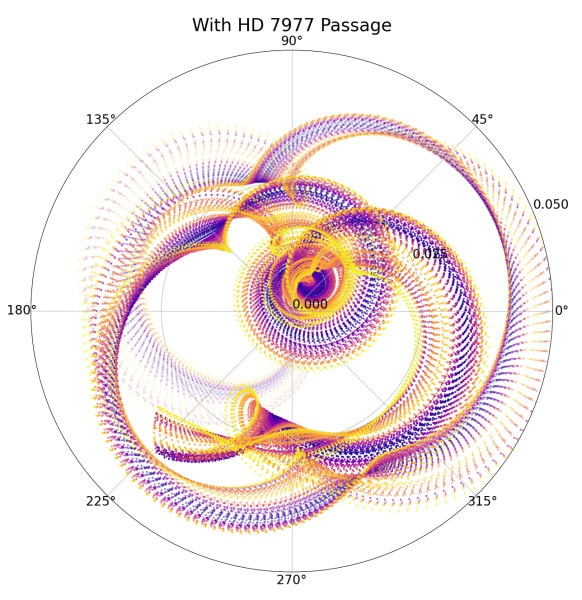
Image: Illustration of the uncertainty of Earth’s orbit 56 million years ago due to a potential past passage of the Sun-like star HD7977 2.8 million years ago. Each point’s distance from the center corresponds to the degree of ellipticity of Earth’s orbit, and the angle corresponds to the direction pointing to Earth’s perihelion, or closest approach distance to the Sun. 100 different simulations (each with a unique color) are sampled every 1,000 years for 600,000 years to construct this figure. Every simulation is consistent with the modern Solar System’s conditions, and the differences in orbital predictions are primarily due to orbital chaos and the past encounter with HD 7977. Credit: N. Kaib/PSI.
What’s notable here is that the authors have demonstrated that stellar encounters can be significant drivers for system evolution, an area not as widely studied as the internal dynamics of the Solar System. Here’s their conclusion:
…stellar encounters significantly accelerate the chaotic diffusion of Earth’s orbit and the time back to which numerical simulations can confidently predict Earth’s orbital evolution is ∼10% shorter than previously thought. Second, this chaotic divergence that stellar passages impart on Earth’s orbit results from their perturbations to the giant planets’ orbits, and these perturbations roughly scale with the velocity impulse gradients of stellar encounters. Third, the known encounter with HD 7977 2.8 Myr ago has the potential to unlock new sequences of Earth’s past orbital evolution beyond 50 Myr ago that have not been considered or generated in previous modeling efforts. Although it takes tens of Myr for the effects of stellar passages to significantly manifest themselves, the long-term orbital evolution of the Earth and the rest of the planets is linked to these stars.
We seem to have overestimated our ability to describe Earth’s orbital state in earlier eras given what we’re learning about the disruptive effects of stellar encounters. These close brushes with other stars can potentially cause changes in eccentricity that have been overlooked. Factoring stellar encounters into future models is going to be complicated, and necessary.
The paper is Kaib & Raymond, “Passing Stars as an Important Driver of Paleoclimate and the Solar System’s Orbital Evolution,” Astrophysical Journal Letters 962 (14 February 2024) L28 (full text). The Hansen and Zuckerman paper I mentioned above is “Minimal conditions for survival of technological civilizations in the face of stellar evolution,” Astronomical Journal Col. 161, No. 3 (25 February 2021) 145 (full text). See also Bobylev & Bajkova, “Search for Close Stellar Encounters with the Solar System Based on Data from the Gaia DR3 Catalogue,” Astronomical Letters Vol. 48 (13 February 2023), 542-549 (abstract).

Musings on Red Dwarf Planets
I’m going to start in the Kuiper Belt this morning before going further out, because the news that the Belt may extend much further than expected reminds us of the nature of exploration. The New Horizons spacecraft, well beyond Pluto’s orbit and approaching 60 AU from the Sun, is finding more dust than expected. Our theoretical models didn’t see that coming. In fact, the dust produced by collisions between Kuiper belt objects was thought to decline as we approached the Belt’s outer edge.
So just where is that outer edge? It had been pegged around 50 AU but now looks more like 80 AU, if not further out, a finding corroborated by the fact that New Horizons scientists have used Earth-based resources like the Subaru Telescope in Hawaii to find numerous KBOs beyond the assumed boundary. Is this a new population of Solar System objects, or are we actually seeing something more mundane, such as radiation pressure pushing inner belt dust further out than would be expected? It takes patient observation to decide, and to re-shape our notions according to hard data.
Which gets me into exoplanet territory, and specifically our understanding of red dwarf stars. Theory is always malleable and yields to observation which, in turn, re-energizes theory. Michaël Gillon (University of Liége), who is among other things the discoverer of the TRAPPIST-1 system, made this point in a recent email exchange. He was responding to my article What We Know Now about TRAPPIST-1 (and what we don’t) with a much needed note of caution. The question of whether rocky planets orbiting M-dwarf stars can retain atmospheres is one of the hottest controversies going. Observations, says Gillon, will tell the tale, not theory, no matter how elegant the latter. After all, we now have JWST, and a new generation of telescopes already under construction to help.
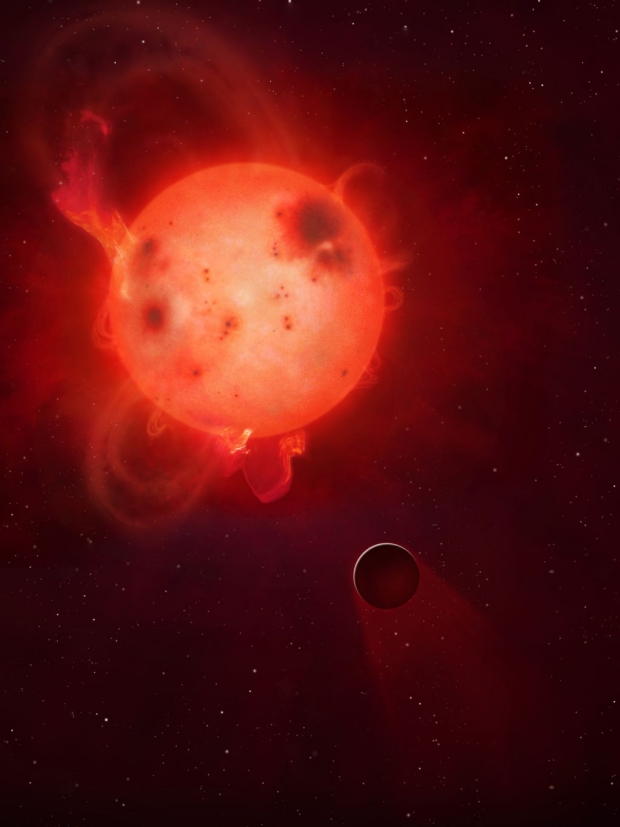
Image: An artist’s concept of Kepler-438b, shown here in front of its violent parent star, a red dwarf. It is regularly irradiated by huge flares of radiation, which could render the planet uninhabitable and possibly strip it of its atmosphere entirely. A variety of mechanisms for depleting the atmosphere of such a planet are now under discussion, using a wide range of models. Image credit: Mark A Garlick / University of Warwick.
On that score, it’s useful to look at a paper that Gillon suggests in his email, a study by Ignasi Ribas and collaborators that appeared in Astronomy & Astrophysics in 2016. The paper does a deep dive into the question of the habitability of Proxima Centauri b, that tantalizingly close Earth-mass planet in the star’s habitable zone. A key issue is whether the extreme dosing of X-ray and ultraviolet radiation such a planet would suffer would compromise a young atmosphere or prevent its existence at all.
There is a lot going on in the Ribas paper, but Gillon pointed me to its discussion of what we might learn from the lesson of our own Earth. Here the essential fuzziness of theory manifests itself, as Ribas and team point out how many uncertainties exist in our estimates of volatile loss, including the telling line “…they rely on complex models that were never confronted to actual observations of massive escape.” Even more telling is the lack of sufficient information about what might prevent such escape:
None of the available models include all the mechanisms controlling the loss rate, for example, the photochemistry of the upper atmosphere and its detailed interaction with the wavelength-dependent stellar emission, non-LTE [Non-Local Thermodynamic Equilibrium] cooling processes, and an accurate description of the outflow beyond the exobase where hydrodynamics no longer apply. Some key data are not known, like the intrinsic planetary magnetic moment, now and in the past, the detailed evolution of the atmospheric composition, of the high-energy spectrum and of stellar wind properties.
Nor do we have hard data on these things even now. Note the term ‘non-LTE cooling’ above. An LTE system is one in thermal equilibrium, maintaining a single temperature. Poking around in the literature, I learn that the lack of thermal equilibrium involves processes that have to be carefully measured to build an accurate profile of an atmosphere, with ramifications for any discussion of its long-term survival. In the absence of such data, it’s telling that other factors remain unknown, including local magnetic conditions and the actual properties of the stellar wind affecting the planet. And we have no good modeling for how volatiles may be distributed between the atmosphere of an M-dwarf planet and the internal processes that can replenish it.
Thus the Ribas paper, although eight years old, remains pertinent to this ongoing discussion, as scientists attack volatile retention in such systems. The authors point out that the protoplanets that built up the early Earth were exposed to a young Sun that was blasting our planet with X-rays, ultraviolet and stellar wind conditions that may equal, and perhaps surpass, what occurred at Proxima b. Note this (italics mine):
The XUV irradiation and stellar wind on the proto-Earth was therefore comparable, and possibly higher, than that of Proxima b. Proxima b spent 100–200 Myr in runaway before entering the HZ, which is longer than the runaway phases experienced by the proto-Earth by a small factor only (<10). Models predict that early Earth suffered massive volatile losses: hydrodynamic escape of hydrogen dragging away heavier species and non thermal losses under strong stellar wind exposure and CMEs (Lammer et al. 2012). Nonetheless, no clear imprint of these losses is found in the present volatile inventory.
The authors point out, then, that geochemical evidence alone shows us no signs of significant depletion of Earth’s inventory of volatiles, which can lead to the possibility that volatile loss was extremely limited under conditions that some of our models would suggest should deplete them radically. If this analysis is correct, then the idea that the planets of red dwarf stars will likely be barren rock stripped of atmospheres is questionable. I come back to Gillon’s point. We’re only going to know from observation, just as we can only know about the extent of the Kuiper Belt through hard data.
Now comes a new paper from Ofer Cohen (University of Massachusetts) and colleagues. Writing in The Astrophysical Journal, the authors again address the TRAPPIST-1 question, this time with a new twist. They’re looking at electric currents that would be produced in the ionosphere of TRAPPIST-1e, a planet that may be in the star’s habitable zone. The question is whether such currents would produce atmospheric heating that would contribute to dissipating the atmosphere entirely.
So this is another stripping mechanism to consider, one produced by the planet’s upper atmosphere encountering the star’s changing magnetic field as the planet proceeds along its orbit. The operative term is ‘Joule heating.’ I only received the paper this morning, so I won’t go too deeply into it. But my early reading suggests that the results from the models used in it point to serious atmospheric loss. This adds to earlier modeling involving the stellar wind and ionized upper atmosphere, some of this conducted by the same authors. The conclusion draws naturally from the modeling:
The JH [Joule heating] is the result of a dissipation of electric current, which is driven by the rapidly varying magnetic field along the planetary orbit. We estimate the JH energy flux on the exoplanet Trappist-1e as well as similar planets orbiting the Sun in close-in orbits. We find that the JH energy flux is larger than the anticipated EUV energy flux at the planet, and it may reach a few percent of the stellar constant energy flux. Such an intense heating could drive a strong atmospheric escape and could lead to a rapid loss of the atmosphere. Thus, the rapid orbital motion of short-orbit exoplanets may exhaust a significant portion of their atmospheres over time.
Again we find useful theories painting a landscape of possibilities. But it’s also true that we lack observational data on the properties of the stellar wind, its evolution over time, and the magnetic fields affecting the planet. The authors call attention to this fact:
VDJH [voltage-driven Joule heating] depends on the variations of the interplanetary magnetic field (IMF) strength along the planetary orbit. Such detailed IMF data are not available for exoplanets (some observations were made for the stellar wind interaction with the interstellar medium; e.g., Wood et al. 2021), nor it is available for short orbits around the Sun (limited data at specific locations are available from the Parker Solar Probe; Raouafi et al. 2023). Due to the lack of observational constraints, we must rely on models to estimate the relevant stellar wind conditions.
Thus energy output, stellar wind and magnetic field changes all factor into a model that suggests atmospheric escape and, like other models, is in need of confirmation with future instrumentation. We can only turn to such observation to begin to understand how diverse theories mesh. I think all the scientists involved in the study of planetary atmospheres around M-dwarfs would agree with this. And headlines in the popular media announcing barren rocks at TRAPPIST-1 are making ongoing investigations into settled science.
Getting too comfortable with theory can mislead us. Recently we saw that the astronomer Otto Struve proposed detecting Jupiter-class worlds in tight orbits around their host stars, only to have the suggestion ignored for decades because ‘hot Jupiters’ simply didn’t fit into then current thinking.
For that matter, nobody thought ‘super-Earths’ were likely, especially in the kind of numbers we’ve found them, nor ‘mini-Neptunes,’ and I doubt many were expecting tiny compact systems of numerous planets, like those Gillon identified at TRAPPIST-1. All in all, I appreciate Gillon’s reminder that patience and data gathering are needed as we explore the question of life around small red stars, an issue that is under deep study but has been by no means resolved. Perhaps the Habitable Worlds Observatory (Habex) will allow a definitive answer for TRAPPIST-1 in the not so distant future.
The Ribas paper is “The habitability of Proxima Centauri b I. Irradiation, rotation and volatile inventory from formation to the present,” Astronomy & Astrophysics 506 (2016), A111 (full text). The Cohen paper is “Heating of the Atmospheres of Short-orbit Exoplanets by Their Rapid Orbital Motion through an Extreme Space Environment,” The Astrophysical Journal 962 (16 February 2020), 157 (full text).

